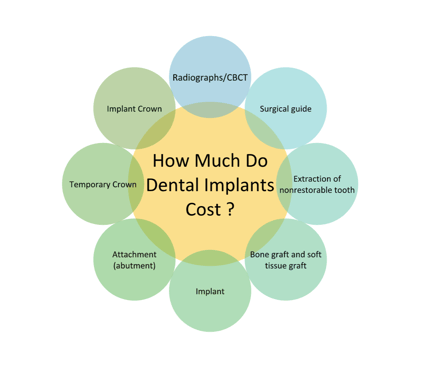Ever caught yourself wincing at the mention of dental implants, muttering about their steep price tag? You're not alone. It's a sentiment echoed far and wide. While the upfront cost of dental implants is certainly higher than other tooth replacement options, definite advantages make implants cheaper in the long run! So, before you write off them as a budget-buster, let's uncover why implants are a savvy solution to missing teeth.
Patients might not know that while an implant replaces a single tooth, it also helps restore balance to your full mouth and gives your teeth stability. Think of dental implants not just as tooth replacements but as guardians of your dental health, silently restoring balance to your mouth's ecosystem. - Dr. Thakkar
When you are missing a tooth, things begin to shift, and the bite doesn’t stay the same. You will begin to use your other teeth more to make up for the one missing tooth. Over time, this can lead to more expensive and extensive treatments down the road.
Based on the American Dental Association’s Health Policy Institute cost survey:
The total cost of an implant, abutment, crown, and other necessary procedures can range from $3,100 to $5,800.
The main reason why there’s no standard price is that no two implant procedures are the same. This is mainly due to the multiple steps of dental implant placements, which may also be performed by multiple specialists such as periodontists, oral surgeons, and prosthodontists.
A dental implant treatment is made up of the following main components:

- CBCT: A Cone Beam Computerized Tomogram, or CBCT for short, will help the dentist with several surgical considerations, such as the position and size of implants, the location of important anatomical structures, and the distance between adjacent teeth.
- Surgical guide: Guided implant surgery allows clinicians to develop a restoratively driven surgical plan, reduce surgical time, and improve accuracy in aligning implants.
- Extraction of nonrestorable tooth: Extraction could be simple or surgical.
- Bone graft and soft tissue graft: In most cases, a graft is placed at the time that the natural tooth has been extracted. This is done to preserve the site for the coming implant. At times, grafting is required after a tooth has been missing for an extended period and some bone loss and soft tissue loss have already occurred.
- Implant: This is the titanium root that goes into the bone. The bone heals around the titanium and integrates with the fixture to provide stability.
- Attachment: Commonly called an abutment, this is what is screwed into the fixture to act as the base of the crown.
- Temporary Crown: A temporary crown can be placed immediately after surgery. Your mouth needs time to heal before the final crown can be placed.
- Implant Crown: (I don’t prefer to say permanent crown) This is the replacement tooth that is
attached to the implant. i.e., the part you see.
Whether you need to replace one tooth, multiple teeth, or a full arch, dental implants are the restoration method that gives you a permanent, long-term replacement option with teeth as strong and aesthetically pleasing as natural teeth.
And while you may first think dental implants are expensive, there are definite advantages to dental implants that make them a better investment over the long run. Why? Dental implants restore balance to your full mouth by integrating into the bone, enabling bone to continue growing and stabilizing your teeth. When you are missing a tooth or have a fixed bridge or dentures, spaces below the gum line shrink and shift, and your bite doesn’t stay the same. You will begin to use your other teeth more to make up for the missing tooth or teeth. This frequently leads to more extensive treatments – and more expensive treatments – down the road.
Bonus Tip: When looking at dental insurance, be sure to ask about a "Missing Tooth Clause." If you are missing a tooth when you purchase a policy with such a clause, they will not pay anything to replace that tooth. But if you include the clause before you lose a tooth, you will have some coverage for its replacement.
Written by Dr. Radhika Thakkar, BDS, MPH. Dr. Radhika Thakkar is a seasoned dental professional with over a decade of experience, transitioning from a dedicated student to a passionate educator. With a rich career journey that began in 2012 after earning her dental degree, she spent transformative years in Indian private practice before pursuing a Master's in Public Health from St. John's University, NY. Her thirst for knowledge led to a rigorous 2-year AEGD residency at the Eastman Institute of Oral Health, University of Rochester, NY. Dr. Thakkar's profound commitment to advancing dentistry and public health is evident through her extensive research portfolio of 20 internationally recognized scientific papers.
Dr. Radhika Thakkar is a seasoned dental professional with over a decade of experience, transitioning from a dedicated student to a passionate educator. With a rich career journey that began in 2012 after earning her dental degree, she spent transformative years in Indian private practice before pursuing a Master's in Public Health from St. John's University, NY. Her thirst for knowledge led to a rigorous 2-year AEGD residency at the Eastman Institute of Oral Health, University of Rochester, NY. Dr. Thakkar's profound commitment to advancing dentistry and public health is evident through her extensive research portfolio of 20 internationally recognized scientific papers.
Follow her Instagram @dr.radhika.thakkar for more information.
Acknowledgment: I would like to express my sincere gratitude to Dr. Joseph DiDonato for the invaluable lessons from the AGD authorship and speaker training courses. These courses equipped me with essential skills that have greatly contributed to the creation of this article. Thank you, Dr. DiDonato, for your continuous support and mentorship.





